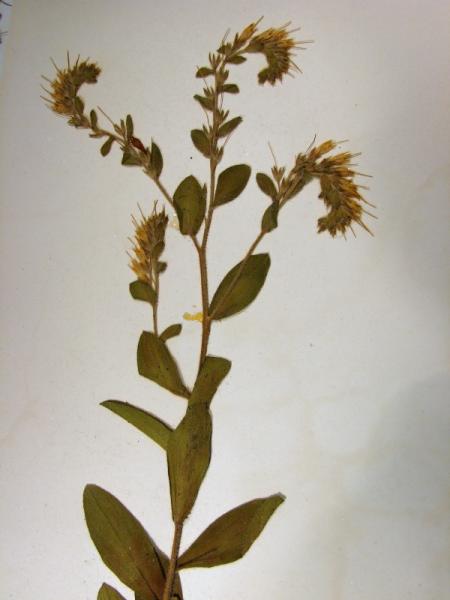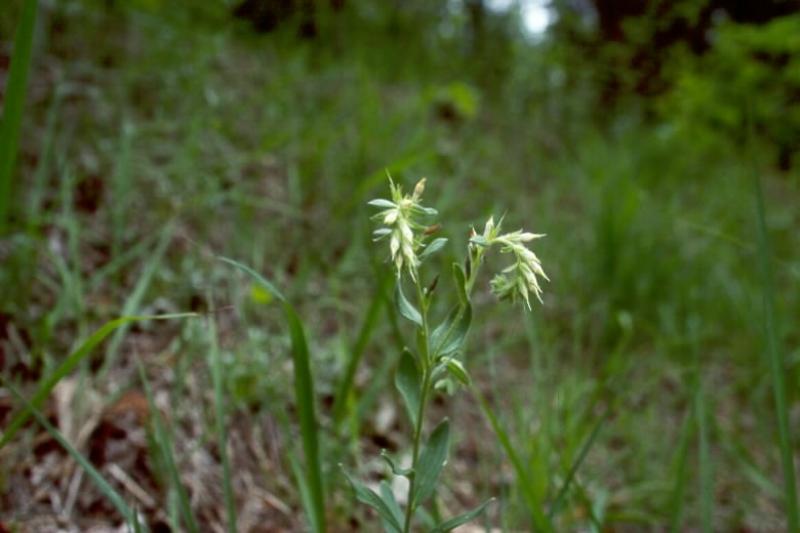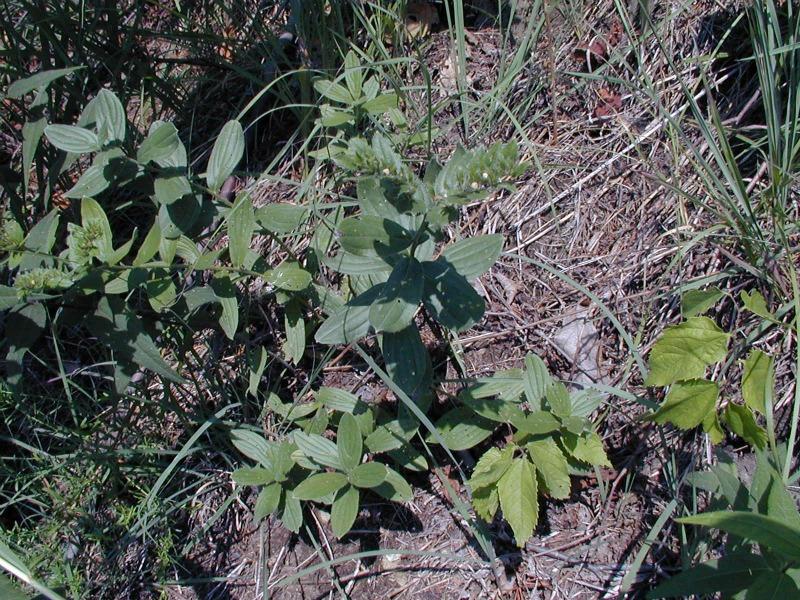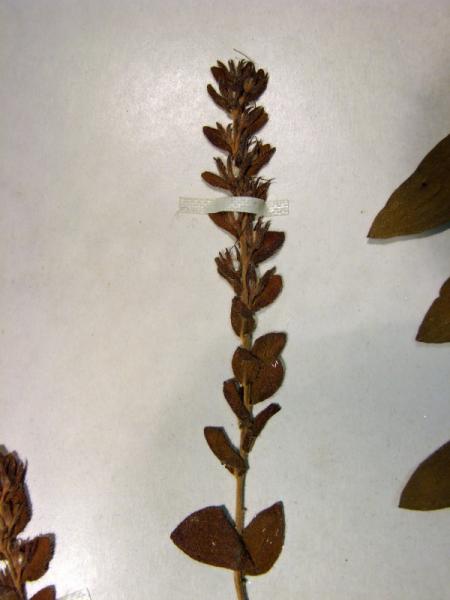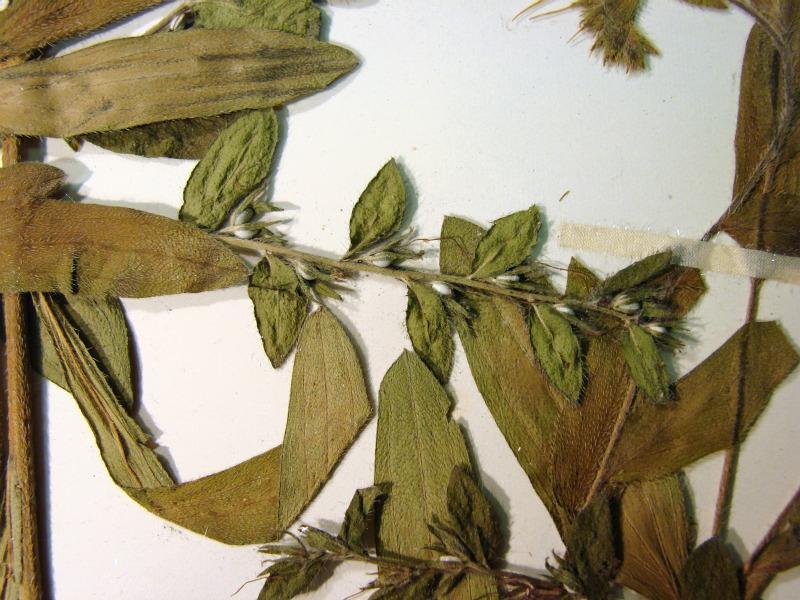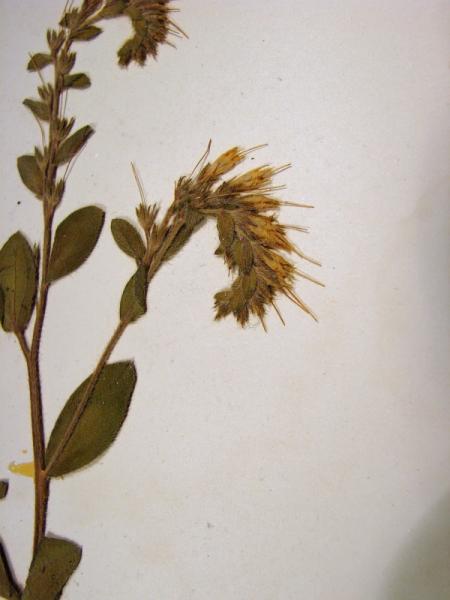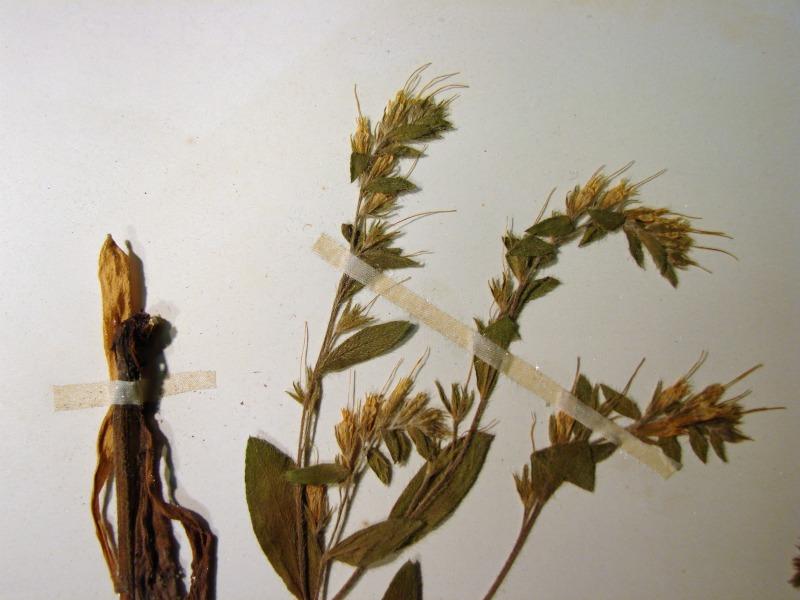Virginia False Gromwell
Lithospermum virginianum L.
- Class
- Dicotyledoneae (Dicots)
- Family
- Boraginaceae (Borage Family)
- State Protection
- Endangered
Listed as Endangered by New York State: in imminent danger of extirpation in New York. For animals, taking, importation, transportation, or possession is prohibited, except under license or permit. For plants, removal or damage without the consent of the landowner is prohibited.
- Federal Protection
- Not Listed
- State Conservation Status Rank
- S1
Critically Imperiled in New York - Especially vulnerable to disappearing from New York due to extreme rarity or other factors; typically 5 or fewer populations or locations in New York, very few individuals, very restricted range, very few remaining acres (or miles of stream), and/or very steep declines.
- Global Conservation Status Rank
- G4
Apparently Secure globally - Uncommon in the world but not rare; usually widespread, but may be rare in some parts of its range; possibly some cause for long-term concern due to declines or other factors.
Summary
Did you know?
The genus name Onosmodium comes from this plant's similarity to the Eurasian genus Onosma, also in the Borage family.
State Ranking Justification
There is one existing population of approximately 20 plants. There are 22 historical records mostly from the late 1800s and early 1900s from open disturbed areas on Long Island and the Lower Hudson region. The probability of relocating more populations is low because many of the areas have been developed or have been previously searched.
Short-term Trends
The one existing population has been stable at low numbers for the last 20 years.
Long-term Trends
None of the 22 historical records from the late 1800s and early 1900s have been relocated because they are from areas that have been developed or have succeeded to other vegetation. This decline has not been offset by new discoveries in other areas.
Conservation and Management
Threats
There are no immediate threats to the current population. Future threats could include succession by woody plants and invasion by exotic species.
Conservation Strategies and Management Practices
Open areas need to be maintained without directly damaging plants. This can be done at the appropriate time of year after seed has been disbursed.
Research Needs
Research is needed to determine the specific habitat requirements of this species and why it was not able to survive in the existing habitat that remains on Long Island and the Lower Hudson region.
Habitat
Habitat
The sole extant record for this species in the state is at an inland red cedar barrens, where it is found growing in calcareous soil with exposed bedrock and a mixture of trees, grasses and herbs. Most of our historical records are from the Long Island and New York City area, and indicate only that it was found in sandy, open sites. Elsewhere in its range it also occupies these two distinct habitat types: both open maritime uplands and inland limestone or other rocky calcareous sites (New York Natural Heritage Program 2007). Pinelands, dry sandy woods and open sands (Fernald 1970). Dry woods and barrens (Gleason & Cronquist 1991).
Associated Ecological Communities
- Calcareous red cedar barrens
(guide)
A small-patch calcareous rocky summit community occurring on dry, south-facing to southwest-facing slopes and low summits. These sites are characterized by stunted, sparse woodlands with small grassland openings.
- Maritime grassland*
(guide)
A grassland community that occurs on rolling outwash plains of the glaciated portion of the Atlantic coastal plain, near the ocean and within the influence of offshore winds and salt spray.
* probable association but not confirmed.
Associated Species
- Anemone canadensis (Canada anemone)
- Asclepias viridiflora (green milkweed)
- Bouteloua curtipendula
- Carya glabra (pignut hickory)
- Draba verna (spring whitlow-grass)
- Hedeoma hispida (rough-pennyroyal)
- Juniperus virginiana
- Schizachyrium scoparium
Range
New York State Distribution
In New York Onosmodium virginianum has been collected from Long Island and from scattered locations in the Hudson Valley, from New York City to as far north as Albany County. The only known extant site is in Dutchess County.
Global Distribution
This species is found along the Atlantic and Gulf Coasts, from New York (and believed to be extirpated from Massachusetts) in the north to Louisiana in the south. It is of conservation concern in many of the states in the northern portion of its range.
Identification Comments
General Description
Onosmodium virginianum is a perennial wildflower, its hairy stems growing up to 60 cm tall. Its leaves are alternate, narrow, and entire, progressively smaller up the stem and into the branched infloresence as reduced bracts. The flowers are unusual in that the pistil and stamens develop before the petals. The petals are yellow, fused into a tube, and hairy.
Best Life Stage for Proper Identification
This species is best identified when in flower, though it is also possible to identify specimens with mature fruit.
Similar Species
If seen in flower, this species should not easily be confused with anything growing in New York. Onosmodium molle, the only other species of Onosmodium in the state, has white or greenish flowers.
Best Time to See
In New York this species flowers in June and July and the fruits may persist to mid-November.
- Flowering
- Fruiting
The time of year you would expect to find Virginia False Gromwell flowering and fruiting in New York.
Virginia False Gromwell Images
Taxonomy
Virginia False Gromwell
Lithospermum virginianum L.
- Kingdom Plantae
- Phylum Anthophyta
- Class Dicotyledoneae
(Dicots)
- Order Lamiales
- Family Boraginaceae (Borage Family)
- Order Lamiales
- Class Dicotyledoneae
(Dicots)
- Phylum Anthophyta
Synonyms
- Onosmodium virginianum (L.) A. DC.
Additional Resources
Best Identification Reference
Gleason, Henry A. and A. Cronquist. 1991. Manual of Vascular Plants of Northeastern United States and Adjacent Canada. The New York Botanical Garden, Bronx, New York. 910 pp.
Other References
Fernald, M.L. 1950. Gray's manual of botany. 8th edition. D. Van Nostrand, New York. 1632 pp.
Holmgren, Noel. 1998. The Illustrated Companion to Gleason and Cronquist's Manual. Illustrations of the Vascular Plants of Northeastern United States and Adjacent Canada. The New York Botanical Garden, Bronx, New York.
New York Natural Heritage Program. 2010. Biotics database. New York Natural Heritage Program. New York State Department of Environmental Conservation. Albany, NY.
New York Natural Heritage Program. 2024. New York Natural Heritage Program Databases. Albany, NY.
Newcomb, Lawrence. 1977. Newcomb's Wildflower Guide: An Ingenious New Key System for Quick, Positive Field Identification of the Wildflowers, Flowering Shrubs, and Vines of Northeastern and North-Central North America. Little, Brown and Company. Boston.
Rhoads, Ann F. and Timothy A. Block. 2000. The Plants of Pennsylvania, an Illustrated Manual. University of Pennsylvania Press, Philadelphia, PA.
Weldy, T. and D. Werier. 2010. New York flora atlas. [S.M. Landry, K.N. Campbell, and L.D. Mabe (original application development), Florida Center for Community Design and Research http://www.fccdr.usf.edu/. University of South Florida http://www.usf.edu/]. New York Flora Association http://newyork.plantatlas.usf.edu/, Albany, New York
Weldy, Troy W. and David Werier. 2005. New York Flora Atlas. [S.M. Landry, K.N. Campbell, and L.D. Mabe (original application development), Florida Center for Community Design and Research. University of South Florida]. New York Flora Association, Albany, NY. Available on the web at (http://newyork.plantatlas.usf.edu/).
Links
About This Guide
Information for this guide was last updated on: January 18, 2008
Please cite this page as:
New York Natural Heritage Program. 2024.
Online Conservation Guide for
Lithospermum virginianum.
Available from: https://guides.nynhp.org/virginia-false-gromwell/.
Accessed July 27, 2024.
